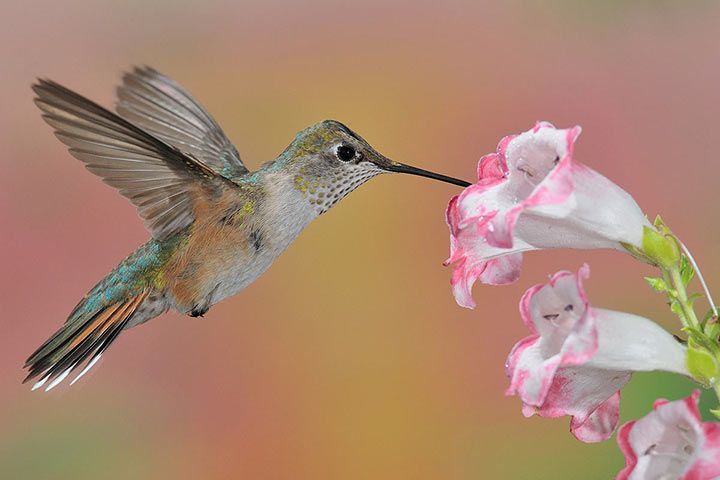Broad-Tailed Hummingbird
Broad-Tailed Hummingbird Facts
| Size | 3.2-3.8 in (83-97 mm); 4.7-5.5 in (12-14 cm) wingspan |
| Speed | Up to 30 mph (48 km/h) |
| Weight | 0.1-0.14 oz (3-4 g) |
| Lifespan | 3-5 years |
| Food | Nectar, insects |
| Predators | Falcons, snakes, lizards |
| Habitat | Texas, Utah, Arizona, Nevada, Wyoming, Colorado; Mexico (winter) |
| Order | Apodiformes |
| Family | Hummingbirds |
| Scientific name | Selasphorus platycercus |
| Characteristics | One of the smallest hummingbirds |
Main Characteristics
The broad-tailed hummingbird is one of over 330 hummingbird species - and has the special ability of flying backwards.
Distribution and Habitat
Broad-tailed hummingbirds prefer open areas of forest with pines, oak, cypress, fir, and shrubs and bushes with flowers.

Anatomy and Appearance
Tail Feathers
The broad-tailed hummingbird is easy to differentiate from other hummingbirds as it has especially broad tail feathers.
Color
The feathers on the male’s throat shimmer in a beautiful pink or bright red. The white rings around the eyes are also typical. The females have spotted cheeks, and their feathers have a subtle pastel coloring in green and brown.
Life Style
At about one year old, hummingbirds are able to mate and start their search for a partner. But hummingbirds only get together during mating season. The rest of the time, they prefer to go it alone.
Behavior
A Cricketlike Wing Trill
Male broad-tailed hummingbirds make a shrill, trilling sound that sounds like a grasshopper chirping. This comes from their wingtip feathers hitting the air in a certain way. After summer, their wingtips have been worn down and they fly silently until they grow back in time for the next mating season in spring.

Abilities and Senses
Calls
Broad-tailed hummingbirds can be very loud! Males can hear their rivals singing at a distance of 160 feet (50 meters).
Sense of Hearing
Females can hear the males singing 245 feet (75 meters) away.
Adaption to the Habitat
There are broad-tailed hummingbirds that live 9840 feet (3,000 meters) above sea level. The higher up you get, the colder the temperatures - that’s the general rule. But there are also small valleys up high, where cold air gathers so it’s warmer higher up. This temperature is the other way round, making it a special phenomenon called “atmospheric inversion”.
The females nesting in the valley manage because they are protected by the warm nest. As soon as it gets colder than 50 degrees Fahrenheit (10 degrees Celsius), they enter a type of brumation to keep their body temperatures to a minimum of 54 degrees Fahrenheit (12.2 degrees Celsius). But what about the males? They leave the valley to sleep at night, flying further up where the air is warmer. This lets them save 15% of their energy.
Life Expectancy
The Oldest Hummingbird
On average, broad-tailed hummingbirds live for about two years. A female in Colorado (USA) was tagged with an ID ring in 1976, and caught again in 1987! The broad-tailed hummingbird was 12 years and two months old, so holds the record for the oldest hummingbird.

Reproduction
They mostly lay two eggs, which hatch within 16-19 days. After just twelve days, the nest is too small and the mother is ousted. After a total of 25 days, the young hummingbirds leave the nest.
Fun Facts
Red Is Their Favorite Color
Hummingbirds often see red, in the truest sense. They are more likely to fly to red flowers with deep openings.



















